 A Review of First City Players' ActOut Performance of "Charlotte's Web" By Sharon Lint-Allen May 01, 2005
Never mind that I am already grown up and in my thirties . . . well, okay, forties . . . but still, there are times when I feel like a child. Take last weekend for example. While watching the performance of "Charlotte's Web" at the Saxman Tribal House, I was suddenly very aware of the nine-year-old hiding inside my forty-something skin. First City Players produced the play with the support of Pioneers of Alaska Auxiliary No. 7. This two-act, non-musical dramatic piece was written in 1983 by Joseph Robinette and was adapted from the beloved classic "Charlotte's Web" authored by E.B. White in 1952 (with illustrations by Garth Williams). 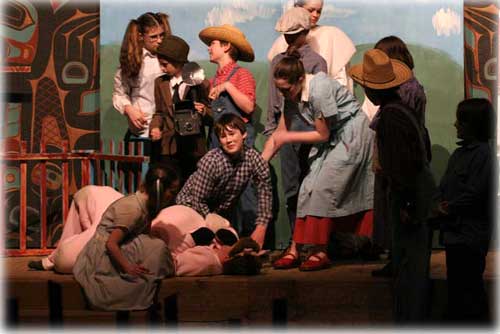 www.carlsphotos.com
Like most of those attending the performance, I remembered the story well from my own childhood. It's about Fern, a young girl who can hear animals speak. She saves a piglet from the butcher's block, names him Wilbur and nurtures him in the kitchen. When he grows too big to be kept as a pet, Wilbur is sold to Fern's Uncle Zuckerman. Safe in the Zuckerman barn, Wilbur comes to meet Charlotte, a wise and caring spider. When Wilbur once again faces the prospect of an unhappy fate, this time Charlotte comes to the rescue by dubbing Wilbur "radiant," "terrific," "some pig" and "humble" and weaving the words into her web. Because of her diligent campaign to save her friend, Wilbur becomes renown as "Zuckerman's Famous Pig," escaping his hammy doom. I expected to be charmed once again by the lightly sorrowful air of the tale balanced by the liveliness of the characters. But I had forgotten how moving Charlotte's dedication, devotion and commitment to her friend, Wilbur, was and how the simple country life portrayed in the story reminded me of my own happy youth in rural Ohio. The venue did a lot to aid in my recalling life growing up on a farm. For those of you who are not familiar with the Saxman Tribal House, it's a native clan lodge and is built of thick, sturdy logs. As such, it lent itself well to the general ambiance needed for the play. Seeing the rafters above, hearing the creek of wooden floorboards below and smelling the fragrance of the red cedar timber made me feel as if I were really on a farm and inside a barn. 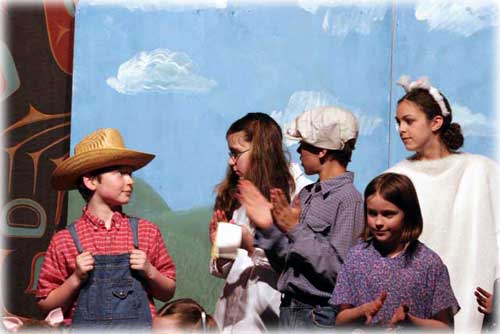 www.carlsphotos.com
Deb Turnbull designed the set. Axel Svenson, Gerald Graham, Marggie Sweetman, Kathy Graham, Franco Deangelo and Milissa Muller aided Deb in constructing and painting it. The design was very straightforward. Here, I was reminded of the adage, "Less is More." There was a center set backdrop that represented a painted fresh-meadow-green field. A few white-cotton-candy clouds dotted a painted robin-egg-blue sky finished the effect. A pigpen moved on and off center stage. A couple of antique lanterns hung from two barn crossbeams and a bale of hay sat at stage right. A large plaque stood back a bit and to one side of the hay with the familiar "Charlotte's Web" book jacket scene displayed. A blue rail fence trailed the left front wall, another penned in a section of the front stage and a third stood in the center pit of the theatre with a gate, indicating the entrance to the Arable's farm. A few bare-branched trees were situated just inside the gated area. Props were few. There were things like John Arable's axe, a slop bucket, the brooms used by the fair cleanup crew, and of course, Charlotte's Web. All items were culled from and managed by Kathy Graham, Kathleen Wiedenhoeft and the mothers, fathers and families of the cast. Although the costumes were also very basic, they aided the actors greatly in forming their characterizations. Designed and assembled by Kathy Graham with the help of the cast and their families, the garments did their job well with a minimum of foo-foo-ism. 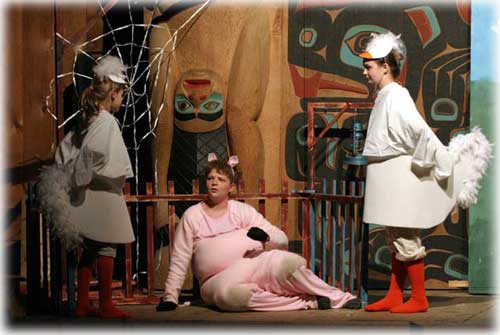 www.carlsphotos.com
All the kids' interpretations of the characters were great. Claire Patton deserves a big round of applause for her hard work as Movement Coach. The time, energy and imagination she must have spent were readily apparent in the vivid gestures and enthusiasm of the children as they played their parts. Connor Jepson played Wilbur, the troubled pig. He sustained a wonderful performance throughout the play. His wide-eyed innocence made him an unusually appealing piglet. Connor deserves huge kudos - not only for his excellent acting, but also because it must have taken a great deal of courage for a young man like him to appear on stage in front of his peers wearing a pink footie-pajama-like outfit. He did an outstanding job, especially when Charlotte asked him to run around and be radiant. His kick in the air was beyond hilarious. Rosemary Svenson carried out an extraordinary performance as Templeton the scruffy, greedy, selfish rat. Rosemary's perky little gray rat ears and scampering, skittering presence was ideal for the part. Her words, "This will be a night to remember in a rat's life!" brought gales of laughter from the audience. When she arrived onstage for the fair scene with Templeton's gluttonous, bulging belly perched on her slim, petite torso, the audience erupted in chortles and hoots again. But the biggest laughs came when Templeton's nasty, smelly egg was broken and Rosemary's little voice wailed in agony, "My egg!" 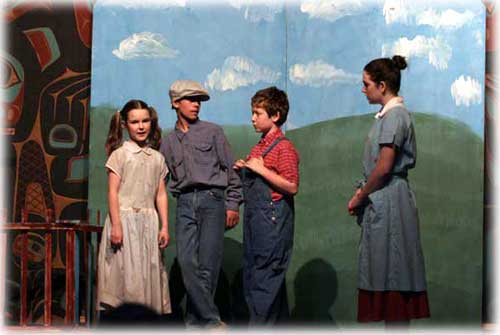 www.carlsphotos.com
John Arable, the farmer with a soft heart for his daughter, was played well by Inga Christensen. His stern face as he strode out with an ax on his shoulder, as the play opened was textbook. Daniel Blasczyk played Lurvy and Brendan Stanton played Avery. Both boys portrayed their characters with a wonderful touch of humor. Charlie Klein and Annie Johnson were fabulous as the Zuckermans. Charlie's cap and lackadaisical manner brought memories to me of the farmers I knew growing up in Ohio's farmland. Edith Zuckerman's purple dress, dishtowel apron and shy, but no-shenanigans attitude when it came to giving Wilbur a milk bath was priceless. Elizabeth Graham was superb as the Old Sheep and also joined in with the other chickens to verbally peck at Wilbur from time to time. Marika Garner was another student who played a perky chicken, but was most noticeable as the lovely goose. Likewise, Alexa Zelensky took the pecking part of a chicken, but also played a great gander. Skyler Smith was shyly cool as the loveable little white lamb with small black mittens. Carson Barnes was accomplished as both the announcer and the photographer. Libby Palazzetti portrayed Uncle, the Pig with a capital "P." Her crudeness at joking coupled with her wide-stride-walking skills made her a flawless blue-ribbon winner. Libby also played a very convincing Reporter. Taylor Henderson, Mikala McKim and Emily Wood were the Fair Cleanup Crew. They did a great job of combining their voices for the "At the Fair" lines and looked the part with their attire and languidly sweeping brooms. Jeanette Sweetman, Alex Blasczyk and Jacie Benitz were the Haystack and Pitchfork. Playing inanimate objects can sometimes be very difficult and they did an excellent job. 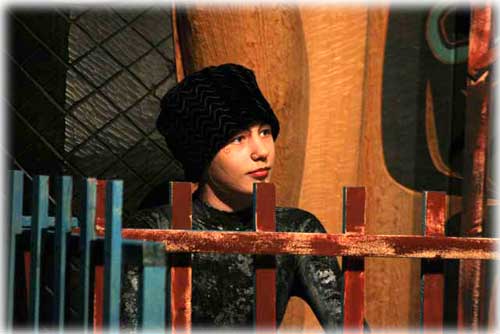 www.carlsphotos.com
I wasn't the only one to admire Charlotte either. I noticed that during her lines, the children were especially quiet, sitting on laps or spellbound on chairs, the usually rambunctious boys now still, standing tip-toe on planks to see better. At intermission, the fascination the kids had for Charlotte was even more apparent. The warm evening and summer dusk lured the children outside of the Tribal House where they played at the outskirts of the trees there, imitating the spider's movements and weaving their own webs of imagination. As I sat watching them in my grown-up human skin, I must admit I wanted to join in with the kids. I wanted to give in to that little nine-year-old inside me and pretend to be Charlotte. I wanted to climb free of the confines of a broken eggshell and sail away in the big world's breeze on little hope clouds of spider silk. I wanted to be a moral, noble, kind, compassionate, caring, loving friend and mother. And I wanted to do and be those things for the rest of my life, not for just ten minutes of intermission. But then the lights flickered, the children returned to their seats, and the play resumed. As it came to its conclusion, Wilbur was saved and returned to the Zuckerman farm. Charlotte died at the fair, but her egg sack was retrieved by Templeton and carried back home by Wilbur. Finally, after watching over it carefully, Wilbur witnessed the birth of Charlotte's children and their departure into the world to live their own lives. All but three: Joy (Old English for Joy), Nellie (Greek for "the bright one") and Aranea (a genus of orb-weaving barn spider). You couldn't see them. They were too tiny. You could hear them though. When Wilbur told them, "To you, her daughters, I pledge my friendship forever," you heard them answer in their small voices, "and I pledge mine." That, I think, is Charlotte's legacy. Friendship. As the Wilbur's last line was embraced by the audience's standing ovation, the house lights came back on. As they did, I was struck most by the faces around me. I saw friends everywhere. Friends I had made years before. New friends. Friends yet to make. Perhaps a grownup can't peel back time and become a child again. Maybe a woman in her forties can't grow up to be Charlotte A. Cavatica. But perhaps she can become one of Charlotte's 514 childrens' grandchildren - a living legacy of friendship and caring. It's not a bad aspiration.
Contact Sharon at sharon(AT)sitnews.us Sharon Lint-Allen ©2005
|